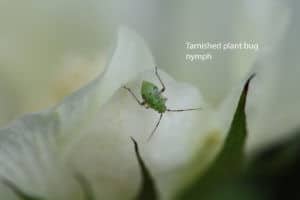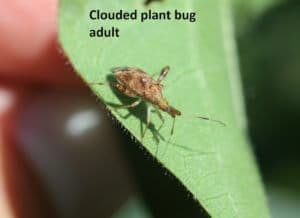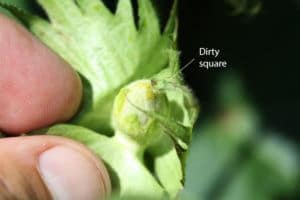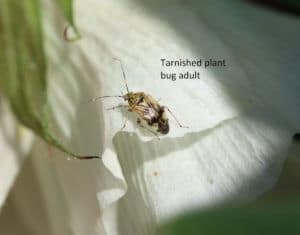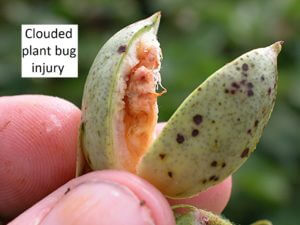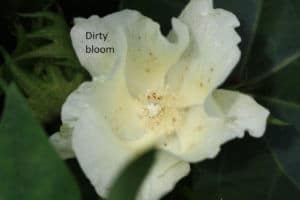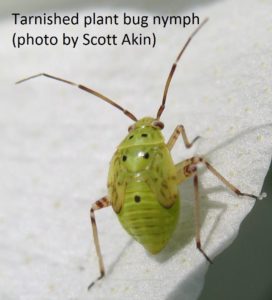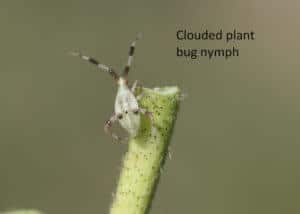
The tarnished plant bug is among the most important pests of cotton. Clouded plant bugs and cotton fleahoppers are two other plant bug species sometimes observed in Tennessee. Both adults and immature stages (nymphs) feed on squares, flowers, and bolls. Small squares and small bolls that have been fed upon will often shed from the plant. This fruit loss can directly reduce yields or delay crop maturity. Bolls that do not shed may have reduced size and quality. Bolls more than 14 days old are not preferred feeding sites and are relatively immune to injury. However, clouded plant bugs will injure larger bolls. Tarnished plant bugs have developed resistance to some insecticides (e.g., pyrethroids). For more information visit the Cotton Insects Tarnished Plant Bug (W025) and Clouded Plant Bug (W110) Fact Sheets.
Small squares and small bolls that have been fed upon will usually shed from the plant. Larger squares may not shed, but evidence of plant bug feeding is evident by yellow staining (“dirty squares”) and anther damage that is observed when a square opens into a flower (“dirty blooms”). Feeding may cause cat-facing (dark spotting) on the surface of the boll, similar to stink bug injury.
Square retention – A management goal is to maintain 80% or higher square retention up to early bloom. Low or dropping square retention can be a warning sign of plant bug problems. Square retention should be monitored prior to flowering and during early bloom. In the top 5 nodes of plants, count the number of shed, first-position squares until at least 25 fruiting sites have been examined and repeat this in at least 4 locations in a field. Record percent square loss.
Sweep net – A sweep net is an effective tool for monitoring adult plant bugs and detecting movement into the field. It is recommended prior to flowering and during early bloom. Take a minimum of 25 sweeps with a standard 15-inch diameter sweep net at 4 locations in a field. Record the number of adult and immature plant bugs.
Drop cloth – Also called a beat sheet or ground cloth, this is the preferred method of sampling plant bugs during bloom because it is more effective at detecting nymphs. The cloth is typically 2.5-3 feet in length, and black is a preferred color. At 4-6 locations in a field, shake plants from two rows over the drop cloth and record the number of adult and immature plant bugs. Record numbers of plant bugs per drop cloth (or per feet of row sampled). Also count stink bugs that may be observed.
First two weeks of squaring: Treat when plant bugs number 8 or more per 100 sweeps or one or more per drop cloth (0.2 per row foot). Treatment should also be considered even if numbers are below threshold if square retention drops below 80 percent and plant bugs are present.
Third week of squaring until first bloom: Treat when plant bugs number 15 or more per 100 sweeps or two or more per drop cloth (0.4 per row foot). Treatment should also be considered even if numbers are below threshold if square retention drops below 80 percent and plant bugs are present.
After first bloom: Treat when plant bugs number 3 or more per drop cloth (0.6 per foot) or 15 or more per 100 sweeps. Count clouded plant bugs as equivalent to 1.5 tarnished plant bugs when determining if populations are above treatment level. Alternatively, treatment can be considered if 10 percent or more of squares show external evidence of plant bug feeding (i.e., 10% dirty squares).
Management options
| Insecticide (Trade Names) for Plant Bugs | Lb Active Ingredient per Acre | Amount Formulation per Acre | Performance Rating |
| PLANT BUGS - Pre-bloom window* | | | |
| acetamiprid (Intruder Max 70WP, Strafer Max 70WP) | 0.074 – 0.101 | 1.7 - 2.3 oz | 6 |
| flonicamid (Carbine 50WG) | 0.081 - 0.089 | 2.6 - 2.8 oz | 5 |
| imidacloprid 2.0 | 0.047 - 0.062 | 3 - 4 oz | 7 |
| imidacloprid 4.0 (Couraze Max) | 0.047 - 0.062 | 1.5 - 2 oz | 7 |
| imidacloprid 4.6 (Admire Pro) | 0.047 - 0.062 | 1.3 - 1.7 oz | 7 |
| sulfoxaflor (Transform 50WG) | 0.047 - 0.071 | 1.5 - 2.25 oz | 8 |
| thiamethoxam (Centric 40WG) | 0.0375 - 0.05 | 1.5 - 2.5 oz | 7 - 8 |
| PLANT BUGS - Blooming window | | | |
| acephate 90 (Orthene 90S) | 0.45 - 0.675 | 0.5 - 0.75 lb | 9 |
| acephate 97 (Orthene 97SP) | 0.49 - 0.73 | 0.5 - 0.75 lb | 9 |
| dicrotophos (Bidrin 8) | 0.31 - 0.5 | 5 - 8 oz | 8 |
| dimethoate 4 | 0.25 – 0.5 | 8 - 16 oz | 6 |
| malathion 5 | 1.25 | 32 oz | 6 |
| novaluron (Diamond 0.83)** | 0.058 - 0.078 | 9 - 12 oz | 7 |
| oxamyl (Vydate C-LV 3.77) | 0.29 - 0.35 | 10 - 12 oz | 6 |
| pyrethroids*** | See labels (use mid- to high-recommended rates) | 2 - 4 |
| sulfoxaflor (Transform 50WG) | 0.047 - 0.071 | 1.5 - 2.25 oz | 9 |
* These products perform better prior to bloom and are primarily recommended in this window. Avoiding the use of pyrethroid, organophosphate and carbamate insecticides prior to bloom is suggested for resistance management.
**This product controls only immature plant bugs. Tank mixes with other insecticides are recommended if significant numbers of adults are present.
***Pyrethroid insecticides will not provide adequate control of tarnished plant bugs. However, tank mixing pyrethroid insecticides with other Phase II recommended insecticides will often improve their performance.
- Plant early maturing varieties.
- Attempt to plant cotton in a block of fields. This improves the efficiency of management and often reduces infestation levels.
- Under heavy pressure, a second application made at a 4-5 day interval may be necessary for best control.
- Insecticide applications can be terminated when cotton has accumulated 250-300 DD60s past NAWF5 (NAWF5 = average of 5 nodes above a first position white flower).

